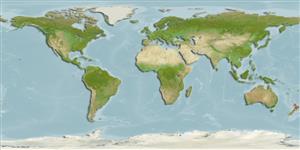Preferred temperature (Ref.
123201): 11.7 - 23.1, mean 17.7 °C (based on 112 cells).
Phylogenetic diversity index (Ref.
82804): PD
50 = 0.5000 [Uniqueness, from 0.5 = low to 2.0 = high].
Bayesian length-weight: a=0.00794 (0.00430 - 0.01467), b=3.02 (2.86 - 3.18), in cm total length, based on LWR estimates for this species & (Sub)family-body (Ref.
93245).
Trophic level (Ref.
69278): 3.4 ±0.3 se; based on diet studies.
устойчивость к внешним воздействиям (Ref.
120179): высокий, минимальное время удвоения популяции до 15 месяцев (Preliminary K or Fecundity.).
Fishing Vulnerability (Ref.
59153): Low vulnerability (10 of 100).
Nutrients (Ref.
124155): Calcium = 242 [117, 552] mg/100g; Iron = 1.26 [0.64, 2.48] mg/100g; Protein = 17.8 [16.7, 19.0] %; Omega3 = 0.206 [0.088, 0.458] g/100g; Selenium = 12.3 [4.9, 31.3] μg/100g; VitaminA = 38.5 [10.2, 153.7] μg/100g; Zinc = 1.64 [1.01, 2.55] mg/100g (wet weight);
